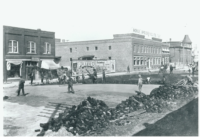No quick decision on Grassy Mountain mine assessment; OWC
By Alejandra Pulido-Guzman - for the Lethbridge Herald dshurtz@lethbridgeherald.com on May 8, 2021.
The Oldman River watershed has been at the centre of the debate regarding coal mining in the Rockies.
There are two coal mines that are being proposed which are undergoing review.
The area covered by the Oldman watershed expands from High River to the St. Mary River system in Glacier National Park, and part of the watershed is in the Blackfeet Nation in Montana and across from Taber to the British Columbia border.
The Oldman watershed has 11 councils across Alberta. They are non-profit and a registered charity, with one of them based in Lethbridge. They are a collaborative forum for solving environmental challenges.
They are a forum for all voices, they provide scientific information and stakeholder views and make recommendations to address concerns of local communities.
“We’re not advocating for any specific choice, we’re sharing scientific information and potential impacts and saying these are the choices that we have,” explained Shannon Frank, Oldman Watershed Council executive director, during a Thursday evening Zoom session organized by the Alberta Liberal Party.
One of the coal mines in question is called the Grassy Mountain Coal project located in the Crowsnest Pass. It expands over 1500 hectares and 25 per cent of it was previously disturbed by past coal mines from the 1960s.
The Oldman Watershed Council (OWC) participated in the joint federal/provincial review of the environmental impact assessment and they noted that the area is the critical habitat of cutthroat trout, grizzly bear, limber pine, grasslands and wetlands. They also noted that selenium is a concern which is known to cause collapse of fish populations.
The other coal mine in question is the Tent Mountain Mine, also located in the Crowsnest Pass. It expands approximately 1700 hectares. They have an active coal exploration permit, with 76 drill holes and 16 test pits. They will require provincial approval for water, environment and reclamation bond.
They are just starting their environmental impact assessment and therefore the OWC reviewed the terms of reference and submitted comments to the Alberta energy regulator. They noted this area to be the habitat for grizzly bear, bighorn sheep and mountain goats. They also mentioned selenium being a concern.
The Environmental Impact Assessment (EIA) is a very lengthy document. The Grassy Mountain Coal project EIA was 12,000 pages. Therefore, once the EIA for the Tent Mountain Mine is ready, the OWC will need to review it and submit comments at a later date.
“For this one, we are not expecting a decision for a year or two, possibly after the next election,” said Frank.
Recently the federal and provincial government developed a strategy to support and enhance mining in Canada. The federal government approved the Canadian Minerals Plan while the provincial government is currently developing a strategy to re-energize Alberta’s mineral sector called Renewing Alberta’s Mineral Future.
The provincial strategy is waiting for approval and the OWC made some recommendations.
“We provided input to try to ensure there was some environmental priorities in there and some accountability,” said Frank.
-1




